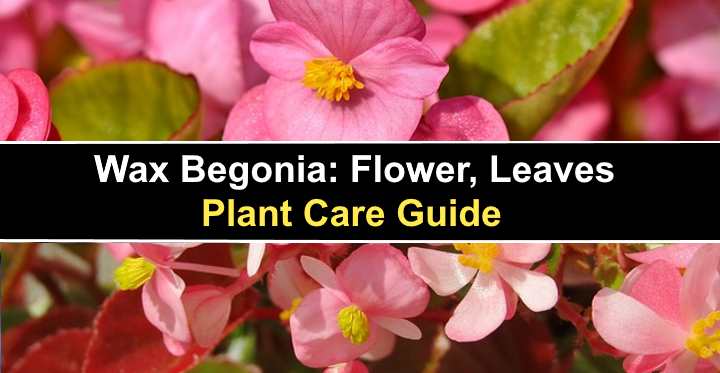Beautiful begonia plants with green, bronze, or reddish-brown waxy leaves that grow in compact, bushy mounds are known as Wax begonia (Begonia Semperflorens-Cultorum). Annuals or warm-weather perennials, wax leaf begonias are popular bedding plants.
The spreading, low-growing bedding begonias produce clusters of white, pink, or red blooms that bloom from summer to autumn. They grow in dappled light and spread out.
Wax Begonia (Begonia Semperflorens-Cultorum) in the Annual Garden
One of the most popular annuals for growing in flower beds, borders, containers, hanging flower baskets, window boxes, and houseplants is wax begonia (also known as bedding begonia). Wax begonias are simple to grow and look after, and they have huge decorative appeal for your garden landscape or home interior.
Because of their extended blooming duration and thick, mound-like development, wax begonias are the most commonly planted bedding flowers. Semperflorens is a botanical term that means “always blooming,” and the rounded or ovate leaves have a waxy gloss.
There are approximately 1,500 begonia species and hundreds of hybrids out there. This article covers both the outdoor and indoor growing of wax begonias. In addition, you’ll learn about the leaves and flowers of this lovely yearly bedding plant, allowing you to maximize its visual impact.
Wax Begonia Plant (Begonia semperflorens-cultorum)

The hybrid genus of begonias Semperflorens Cultorum in the Begoniaceae family contains Wax begonia (Begonias Semperflorens Cultorum). Fibrous roots, fleshy stems, and lustrous, waxy leaves in hues of green and brown characterize Begonia semperflorens. Wax begonias may grow to be 12 inches (30 cm) tall and spread up to 12 inches (30 cm).
Full sun to partial shade is ideal for wax begonias. Dappled light or partial shade is ideal for growing green-leafed begonia semperflorens types. Begonias with bronze and black leaves perform best in full sun. Herbaceous perennials in USDA zones 10 and 11 are wax begonia (begonia semperflorens) plants. Begonias are annual bedding plants that do not tolerate frost in colder climates. Every spring, you can sow begonias as annuals or overwinter them in containers indoors during winter.
Wax begonias are excellent ground cover, hanging baskets, along walkways, container plants, and flowering border plants because of their clumping habit and low spreading. When wax begonias become seedlings, their growth rate is very rapid.
Begonia bedding will develop swiftly and occupy areas in your garden beds and borders after you’ve transferred the seedlings to your garden in the spring. Planting wax begonias in a wide area can instantly dress over bare earth, adding vibrant leaves and blooms to your garden.
Wax Begonia Flower
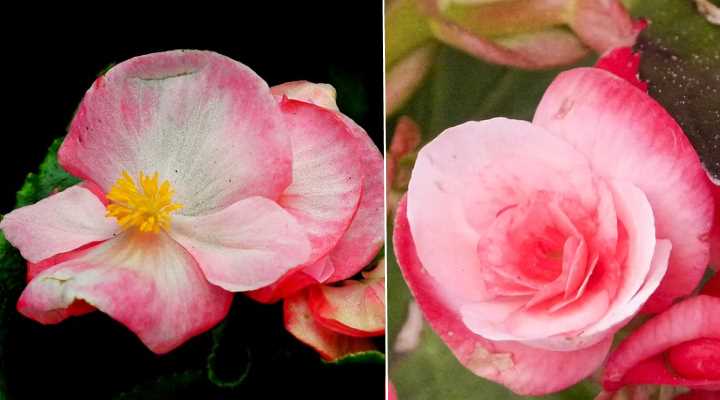
Wax begonia blooms are typically pink, white, red, or a mix of those colors. They come in single and double varieties. Individual begonia flowers develop in loose clusters of single or double blooms, with four or five petals. From May to October, wax begonia blooms create a vibrant carpet of color.
Wax Begonia Leaves

Green or bronze leaves are available on wax begonia, and they have a glossy sheen that makes an attention-grabbing carpet of showy foliage. Green or brown, bronze, or copper leaves cover wax begonia. Light green to dark bronze leaves with a lustrous sheen.
Wax Begonia Plant Care
In moist, well-drained, rich fertile soil, wax begonias thrive best in full sun or partial shade. During hot summers, it’s a good idea to lay down a layer of mulch to retain moisture. To encourage bushy development and prolific blooming, no pruning is required after it has been established.
Water the soil adequately for growing potted wax begonias without making it soggy when watering them. When the top layer of soil is dry, it is time to water begonias in containers. Until the water drains from the drainage holes, pour it evenly around the pot. If the weather isn’t too hot and bright, wax begonias are also drought-tolerant plants.
How to Plant Annual Wax Begonia in the Garden

Annual wax begonias are one of the most simple plants to maintain in gardens, whether they’re in partial shade or dappled light. Little wax begonia seeds must be started indoors since they are tiny. You may plant wax begonias in the ground when the weather is consistently above 50°F (10°C) after the seeds germinate and seedlings develop.
In January or 12 weeks before the final expected frost date, start growing begonia seeds indoors. Don’t cover the powdery seeds with soil since they need light to germinate; sow them in a sterile potting mix. To promote humidity and allow adequate light in, cover with clear plastic. Keep indoor temperatures between 21°C and 24°C. In around 20 days, the seeds should germinate.
When to plant wax begonia: When the danger of frost has passed, plant wax begonias in the ground. The tender annuals will be killed if the temperatures are below 50°F (10°C).
Where to plant wax begonia: Wax begonias should be planted in partial shade or dappled sunlight for the best results. Begonia species with bronze leaves tolerate full sun better than green-leafed begonias. It’s a good strategy to amend the soil with compost before planting if you want begonias to thrive in slightly acidic soil.
How to plant wax begonia: Begonia plants should be spaced about 6 to 8 inches (15 to 20 cm) apart. This ensures that the tender annuals have enough space to grow and get adequate air circulation.
Start wax begonias indoors and place them half inch (2.5 cm) apart on the tuberous roots to grow them into tubers. Keep the soil moist and protect it from sunlight. The tubers should sprout in around 30 days, and you can relocate them to a brighter area. When there’s no longer a danger of frost, plant begonia tubers in the earth.
Pests Affecting Wax Begonia Growing in the Garden
Fibrous-rooted wax begonias are more pest resistant when growing in ideal conditions. Leafy bedding plants can be damaged by whiteflies, aphids, thrips, spider mites, and mealybugs. Inspect the underside of the leaves for signs of pest infestations if you see tiny insects hovering around your wax begonias. Blast away any pests on your plants with a powerful stream of water if you have thrips, aphids, or other pests.
Growing Wax Begonias in Containers
Plants of the wax begonia (Begonia semperflorens) thrive well in containers. Begonia plants may be grown indoors, on patios, decking terraces, or window boxes thanks to their pots. You’ll need a big enough container for the wax begonias, which can grow up to 12 inches (30 cm).
To avoid root rot, the pot must have drainage holes. Position the plant in a bright location but not in direct sunlight when growing potted wax begonias indoors. Wax begonias should be placed in a dappled light or full sun depending on the kind.
Wax Begonia in Hanging Basket
For hanging baskets, wax begonia is a fantastic plant. It brightens up a room, porch, patio, or outdoor decking area with its spreading glossy leaves and dangling stems of pretty pink, red or white flowers. Begonias in hanging flower baskets need excellent drainage, much as they do when growing in containers.
Baskets should be placed in partial or dappled exposure. Wax begonias with green leaves and crimson bases are some of the most stunning. Hanging from a support, the vivid red and green leaves, as well as pinkish-white blooms, create a striking impression. You can appreciate the beauty of these colorful begonias because the plants are at eye level.
How to Overwinter Begonias
Outdoors, wax begonias don’t fare well. To re-grow fibrous-rooted begonias in USDA zones 9 and lower, you’ll have to winterize them first. To preserve wax begonias from the cold, there are a few methods to store them during winter. Dig up the tuberous or rhizome roots in the fall when nighttime temperatures drop below 50°F (10 C). Until next spring, transfer the bedding plants to pots and grow them indoors. It’s a smart idea to transition gradually to indoors.
First, bring the containers in at night and out at morning. Increase the amount of time the wax begonias spend indoors after two weeks. Indoor temperatures, humidity, and light will be introduced to them gradually. Water rarely when the top layer of soil dries to care for potted begonias indoors throughout the winter.
Growing Wax Begonia Indoors
Begonias semperflorens are great houseplants in a variety of colors. The beauty of any room is further enhanced by the glossy circular green or bronze leaves, clusters of little flowers, and spreading nature. Potted wax begonias can bloom continually all year indoors under the right conditions. Let’s examine how to care for wax begonia houseplants in depth.
Where to Grow Wax Begonias Indoors
Indoor wax begonias flourish in a room with adequate air circulation and plenty of light. Begonia plants may be grown in pots or hanging baskets. Ensure that the plant is not in direct sunlight when selecting an indoor location. Glass allows sunlight to shine more brightly than it would outside.
Light Requirements for Potted Wax Begonias
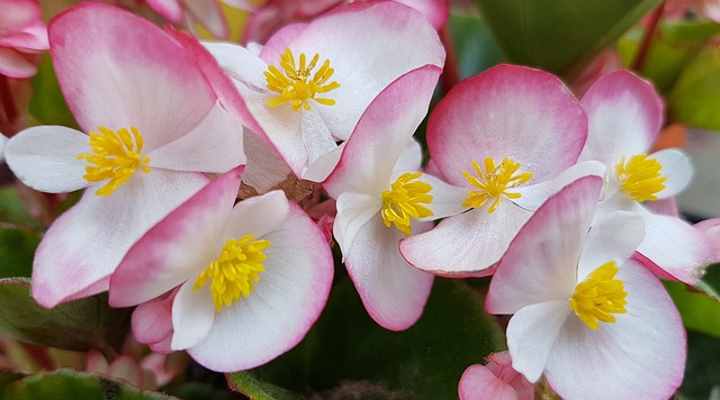
Give wax begonias enough indirect light to care for them properly indoors. To promote healthy development and abundant flowers, select an east, west, or south-facing chamber. Begonias thrives in artificial light when there isn’t enough natural light. Wax begonias should be kept in indirect sunlight because they need the most light.
The Best Soil for Wax Begonias Houseplants
A light, fertile potting mix that drains well is necessary for wax begonias to grow in containers. To improve drainage, use a peat-based potting mix with perlite added. The roots of this kind of begonia can stay moist without becoming waterlogged because to the nature of the soil. Commercial potting mix for African violets is also available.
How to Water Wax Begonia Plants

When the top 2″ (5 cm) of soil is dry in the winter, water wax begonia plants are ideal. You may need to water the tropical potted begonias once or twice a week during the growing season. Pour water into the ground until it runs out at the bottom to watering the plant.
Begonia roots should not sit in watery soil, which is an important growing requirement. As a result, before watering, it is important to let the top layer of potting soil dry. To check for moisture, simply stick a finger into the potting mixture. For watering wax begonia houseplants, here are a few helpful hints:
- Before watering, allow tap water to sit in an open-topped container for 24 hours, allowing chemicals to dissipate.
- To prevent shocking the roots, always use room temperature water.
- Since the begonia houseplants grow slower in the winter, watering less is possible every four weeks or so.
Wax Begonia Temperature and Humidity Requirements
Average room temperatures are ideal for wax begonias. Begonias semperflorens prefer a temperature range of 60°F to 75°F (16°C to 24°C). Non-stop blooming is encouraged by growing in these temperatures. Wax begonias should be grown in a 50% humidity environment, if possible. Sit the plant pot on a pebble tray and water it if the indoor conditions are particularly dry. Just make sure that the pot is sitting on the little stones, rather than in water.
Good ventilation is required for indoor wax begonias. You may see indications of fungal problems on the foliage if there isn’t enough air circulation; a white powdery substance caused by mildew is one example.
Fertilizing Wax Begonias Growing in Pots
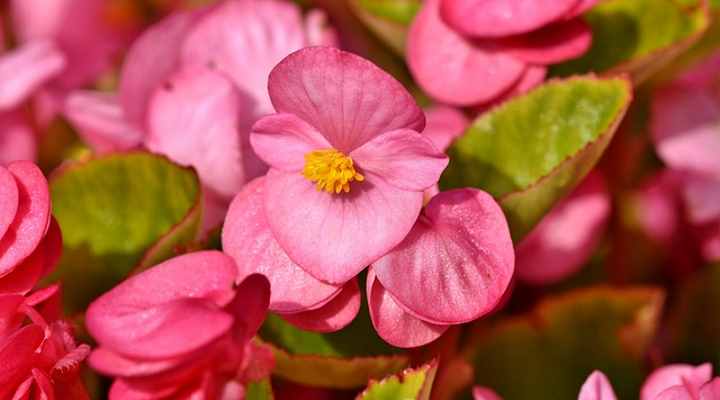
Throughout the spring and summer, fertilize wax begonia lightly with a high phosphorus fertilizer. Use a phosphorus-rich diluted houseplant fertilizer. One that has a NPK rating of 10-20-10 is suitable as a fertilizer. Here are a few tips for fertilizing wax begonia houseplants:
- In the fall and winter, refrain from fertilizing begonias.
- Flush the potting soil every three to four months to prevent mineral salts from accumulating.
- Overfertilizing a begonia houseplant, like overwatering, may be just as harmful.
Pruning Wax Begonias
Removing spent blooms is the only time you’ll need to prune a wax begonia. To improve the plant’s appearance, you can also cut off dead stems or leggy growth. It’s a indication that the plant needs more light if you notice that the wax begonia stems become leggy.
In low light or in full shade, wax begonias do not thrive and do not bloom. To promote compact, bushy development, relocate the plant to a more bright area.
Propagating Wax Begonias

Wax begonias can be propagated by stem cuttings in the best way possible. Cut 4″ (10 cm) long healthy stems in the spring and plant them in a tiny pot with fresh, moist planting mix to root. To create a humid environment, cover the container with a plastic bag. Keep the soilmoisture, but not waterlogged. Your new begonia plant can be grown as usual after a few weeks with roots from the propagated begonia cuttings.
Repotting Wax Begonia
Wax begonias seldom need to be repotted because they are low-maintenance houseplants. When wax begonias have a little root bound, they flourish. To determine if you should repot the begonia, check to see if the plant’s roots are stable enough to hold the potting soil.
Inspect the fibrous roots of a wax begonia for signs of illness or deterioration while repotting. If you need to, before replanting, remove the dead or mushy roots. Fast-growing wax begonias are available. Now, let’s say that a begonia has outgrown its pot. In this situation, propagation from fresh cuttings may be more convenient than repotting the plant.
Pests and Diseases Affecting Wax Begonia Growth Indoors
Thrips and mealybugs are common pests that attack potted wax begonia houseplants. Spider mites may develop if the soil is too dry. Treat the infestation with neem oil if you notice signs of houseplant pests. Add 2 tsp. of salt to the mixer. 1 tsp. of neem oil 1 quart (1 liter) of water and liquid Castile soap Until you get rid of the pests, mix thoroughly in a spray bottle and spray the begonia’s foliage once a week.
Powdery mildew and root rot are two common illnesses that affect wax begonias. Moisture-related problems, either too much humidity or watering, are to blame for both situations. To eliminate the fungal disease from powdery mildew, use a home remedy spray. Mix two parts water with one part regular milk. To assist get rid of the white powdery substance on the leaves, spray them with the milk solution. Repeat every week until the foliage appears to be healthy.
Make sure there is enough air circulation and light to prevent mold issues on the leaves. The leaves of begonia plants turn yellow, and the stems get black and mushy as a result of root rot. It is crucial to repot your plant and eliminate all parts of rotten roots if you notice these symptoms. Taking stem cuttings and growing a new plant may be the most effective option if damage is significant.
Are Wax Begonias Toxic?
Wax begonias, for example, are poisonous to cats and dogs and belong to the Begoniaceae family. Begonia leaves, according to the ASPCA, include soluble calcium oxalates. Vomiting or massive drooling may occur if begonia leaves, stems, or roots are consumed.
Varieties of Wax Begonia
Wax begonias grow as annuals or warm-weather perennials and come in a variety of cultivars. Semperflorens begonias is a group of gorgeous flowers, and here are a few of them:
Ambassador Series Begonias—The thick oval green leaves and huge pink, red, or white blooms of wax begonias in the ‘Ambassador’ series. Pests and drought are resistant to these begonia types.
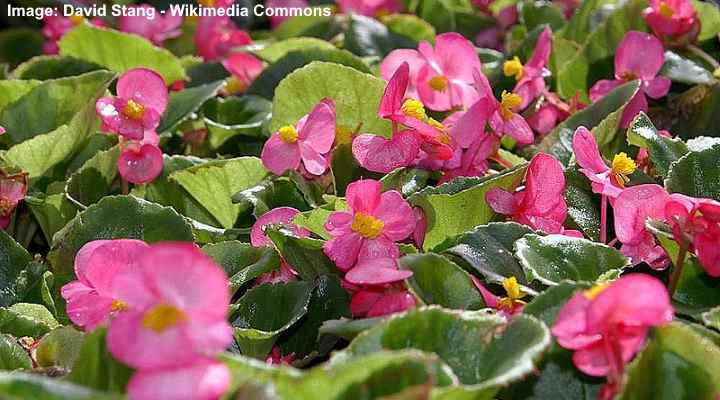
Begonia Ambassador Scarlet—The blooming bedding plant wax begonia has large glossy green leaves and crimson blooms. In hanging baskets, flower beds, and containers, the ‘Ambassador Scarlet’ performs well.

Cocktail Series Begonia—Dark-leafed wax begonias prefer full sun and grow best in cocktail begonias. In garden beds, borders, or sunny window boxes, heart-shaped dark leaves and white, pink, or red blooms are stunning.
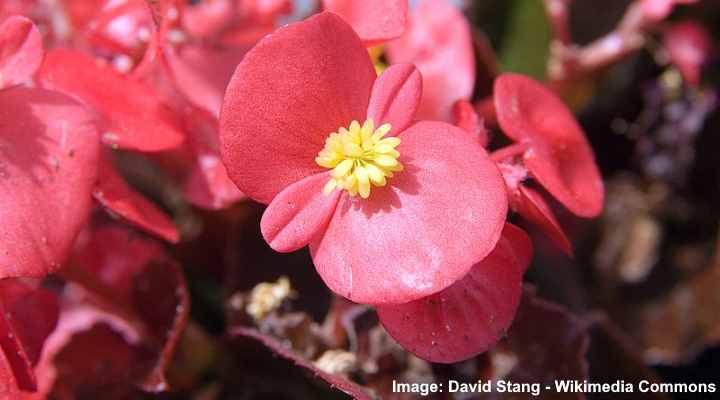
Begonia ‘Doublet Red’—The showy double blooms make the Doublet Red a stunning red-flowered, dark-leafed wax begonia. For maximum impact, plant in large clusters along the boundaries, in pots, hanging baskets, or mixed beds.

Begonia ‘Party’ Series—The ‘Party’ series begonias feature white, red, or pink blooms with dark green or bronze leaves for a dazzling display in any garden. This wax begonia hybrid has broad oval leaves that enable it to take more sunlight than other begonias.

Senator White Begonia—The gorgeous pure white and yellow blossoms of this dark green or bronze-leafed heat-tolerant begonia semperflorens are stunning. It reaches a height of 6 to 8 inches (15 to 20 cm) and a width of up to 12 inches (30 cm).
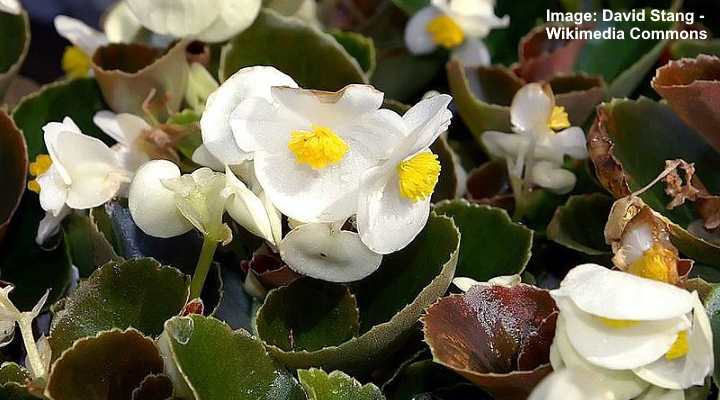
Senator White, a begonia, is one of our featured plants.
